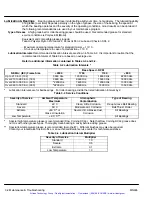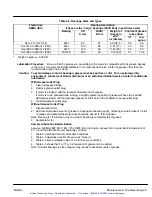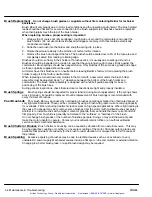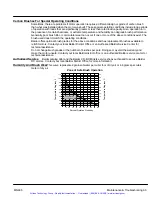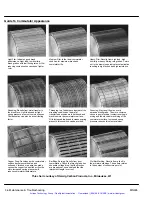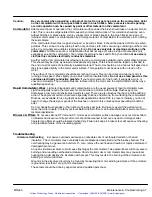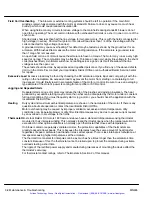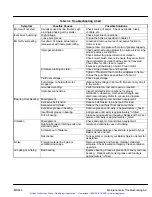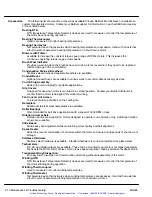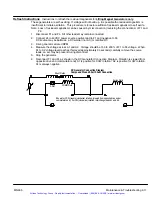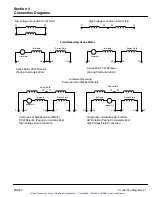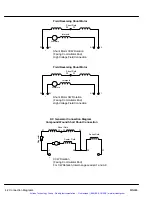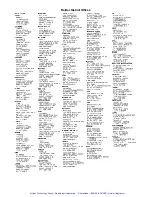
Section 1
General Information
Maintenance & Troubleshooting 3-7
MN605
Caution:
Be very careful when repainting a drip proof motor. Do not get any paint on the commutator. Paint
on the commutator will show up as black marks in brush tracks. Also, excessive brush sparking
or erratic operation can be caused by paint or other material on the commutator.
Commutator
After several hours of operation, the commutator surface under the brush should take on a darker bronze
color. This is due to self-generated film caused by normal commutation. This coloration should be even,
without blotches or black areas. A shiny copper color or black streaks in the brush tracks are signs of
improper commutation or contamination by a foreign material. Contact Baldor for assistance in correcting
these problems.
If the commutator becomes rough and burned, or becomes black, it should be cleaned of dirt and carbon
particles. This can be done by wiping it with a dry, lint-free cloth. Also vacuuming or blowing out the motor
with a dry air supply are suitable cleaning methods.
Do not use solvents or cleaning solutions on the
commutator
. To remove spots or contamination that will not wipe off, wrap a strip of coarse (60# grit)
sandpaper around the commutator. Then rotate the armature back and forth by hand.
Do not use emery
cloth as this contains electrically conductive materials
.
Another method of commutator resurfacing is to use a commercially available commutator dressing stone.
This should only be done by trained and experienced people. This stone should be taped or attached to
the end of a stick made of electrically insulated material. The motor should be run at about half speed and
the stone applied lightly to the commutator surface. This operation must be done with no load on the
motor.
The surface of the commutator should be smooth and round. This can be checked while the motor is
running at low speed. Press lightly on one brush with an insulated stick.
Do not use a lead pencil as this
contains electrically conductive graphite
. If you feel movement of the brush, it suggests a worn or
uneven commutator. The armature must be removed from the motor and the commutator machined by a
qualified repair shop.
Rapid Commutator Wear
Light electrical loads and contamination are the usual causes of rapid commutator wear.
Light loading may require the removal of some brushes on motors with multiple brushes per pole.
Sometimes a low current density brush grade is used. There are also brushes that have a mild polishing
action. These prevent certain chemicals, especially chlorine and silicone, from attacking the commutator.
Brushes, are available for use in plastic extruder applications where PVC is present. Usually, you do not
have to change the design or grade of the brushes on new motors unless special operating conditions
exist.
Do not change brush grades or the number of brushes per pole. Doing so may void the warranty and
make the motor unsafe. Contact your local Baldor district office or an authorized Baldor service center for
technical assistance.
Blowers & Filters
Do not use silicone RTV around DC motors as commutator surface damage can occur. Intake filters
on blowers and louvers of drip proof motors should be cleaned to remove any dust or foreign matter.
Canister type filters should be replaced when dirty. Failure to keep air intakes clear will cause overheating
and premature failure of the insulating system.
Troubleshooting
Armature Overheating
Excessive overloads will cause a noticeable odor of overheated varnish or charred
insulation. The commutator may eventually become blackened and pitted and the brushes burned. This
overheating may be general and uniform. To cure, remove the overload and rewind or replace armature if
damaged beyond use.
An open-circuited armature coil will cause flashing at the commutator. Two adjacent bars will show severe
burning and a resulting overheated armature. Short-circuited coils or commutator bars may cause local
heating that could destroy the insulation at that spot. This may result in the burning of the armature coils,
banding or commutator bars.
Grounds in the armature circuit may be found by measuring the motor winding resistance. If the armature
is grounded, less than 1 meg ohm is measured.
These tests should be done by experienced and qualified personnel.
Artisan Technology Group - Quality Instrumentation ... Guaranteed | (888) 88-SOURCE | www.artisantg.com










